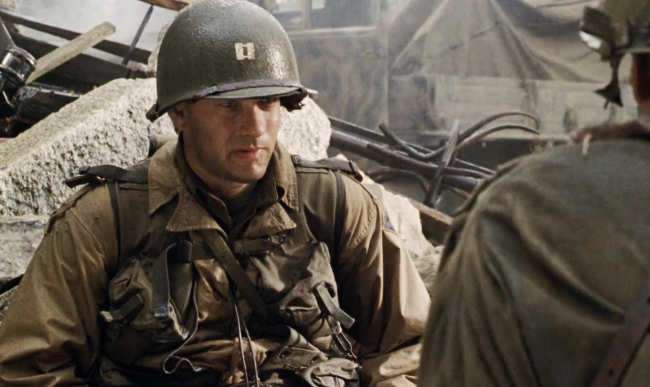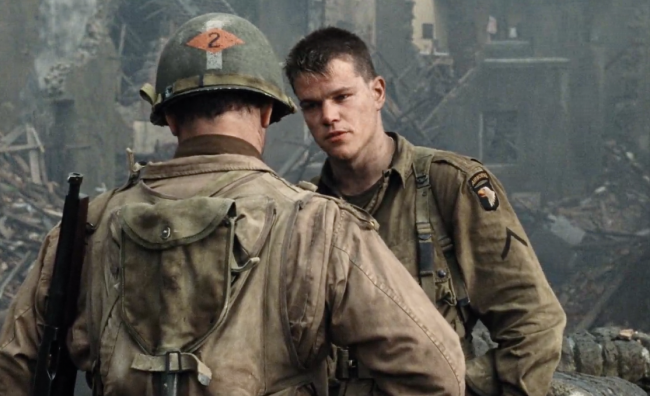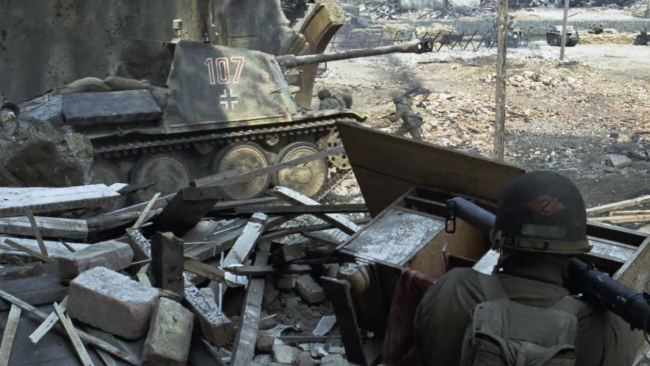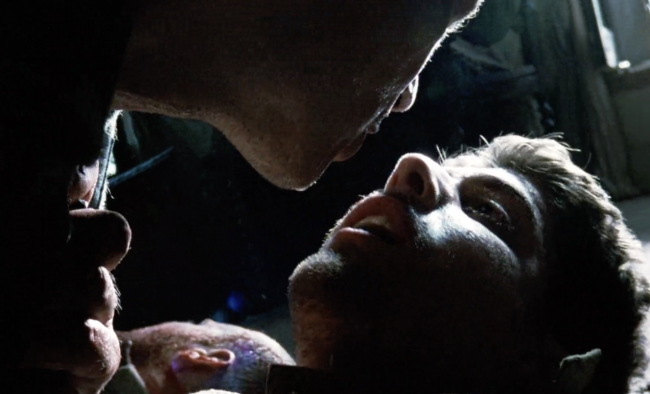
That Moment In Saving Private Ryan (1998): The War of One
Saving Private Ryan is a historical war drama about a group of soldiers tasked with finding the last surviving brother of four after the Normandy Invasion of France in World War II. A multiple award winning epic, and widely considered one of the greatest war films of all time, its graphic depiction of violence and the horrors of battle make it perhaps the most realistic war film ever made.
The conversation about Saving Private Ryan must and always does begin with its opening 27-minute sequence as Allied troops storm the famous French coast as embedded German artillery mount a defense. It’s a terrifying and awesome theatrical experience that nearly defies description, mostly because all the while it’s happening, it’s impossible not to remember that what it depicts is a very real and very important event. Much has been said about this already, so to that end, as much as I could discuss it ad infinitum, there are other parts of the film that deserve a closer look as well. One in particular will be explored here.

But first, a brief recap, or for those who have yet to see it, a synopsis of the film. As mentioned, the story begins–after a short present-day opening of a veteran breaking down at a memorial for his fallen comrades–on an Allied Landing Craft heading to the shores of Omaha Beach. Captain John Miller (Tom Hanks) is one of many aboard and is preparing for the assault. It then erupts into a cacophony of weapons fire and the deafening screams of the wounded and dying. In the aftermath of the traumatizing attack, Miller and most of his squad survive, though thousands do not, including one soldier, face down in the surf. His pack shows the name “S. Ryan”. It turns out, he is the third of four Ryan brothers to die in service to their country so far, leaving only Private First Class James Francis Ryan (Matt Damon), the youngest of the lot, remaining.

Days later, with the beach secure, Miller is given orders to take his squad and make their way inland to find Ryan, a paratrooper now missing in action since the start of the D-Day invasion. His men are of mixed emotions about the mission and the rational of putting eight valuable soldier in harm’s way just to save one. But they press on, and some do not survive. The long journey to Ryan is one not unlike an odyssey, with Miller at the heart, a former teacher now in charge of men, who is bound by his honor and duty to follow his orders but wants nothing more than to find his way home.
Directed by Steven Spielberg, Saving Private Ryan is not without its minor flaws, but it still is a remarkable example of modern filmmaking at its finest, with standout performances, a rousing, highly emotive score (by John Williams), and what might be Spielberg’s best directing achievement. Naturally, its greatest moment is its opening, which in some ways stands on its own, almost independent of the rest of the film. With that in mind, let’s examine another moment that in many ways is well connected to that battle.
The War Of One
Miller and the remaining men of his squad, eventually make it to the blown out town of Ramelle, where they meet Ryan and his leaderless paratroopers holding to their mission, defending a bridge over the Merderet River. Miller takes command after informing the Private of his bother’s deaths, learning that Ryan would rather stay with the only “brother’s” he has left than go home. Meanwhile, a German SS Panzer tank division is approaching. The men formulate a plan to try and stop the overwhelming force.

In Miller’s squad is a young soldier named Timothy E. Upham, a Technician Fifth Grade working as a cartographer and interpreter before assigned to Miller’s team. He has no battle experience and is meek and timid. In an earlier scene, he even convinces Miller to allow a captured German, one Miller could not keep custody of due to his present circumstances, to go free rather kill him, a decision that will have great consequence later. Upham is put in charge of the ammunition for the coming bridge defense, layering his neck in long bandoliers full of bullets. The others take positions about the rubble and debris, hoping to take out as many enemy elements as possible until re-enforcements arrive.
The fight is horrific, a close-quarters chaos of tank fire, sniper shots, and machine gun volleys. One of Miller’s men, Private Stanley “Fish” Mellish (Adam Goldberg), a rifleman, joins another on the second floor of an abandoned, gutted home and mounts an attack at German ground troops but runs out of ammo fast. They call to Upham to deliver more, but he is caught in crossfire and hesitates before making his way to the bottom floor of the near collapsed building. Once there, a Panzer crests the brick-strewn street nearby, flanked by a handful of German soldiers in support. This causes Upham to hold his position instead of bolting to Mellish, shown to be an act of cowardice and fear.
Two Germans make it up the stairs without seeing the hiding Upham who watches in terror. The first German is killed by Mellish and his partner and in return fire, the Allied soldier is shot in the throat, falling to the floor in agony before bleeding out. Mellish, with no more ammunition, is forced to lunge at the German in the doorframe and the two engage in vicious hand-to-hand combat. This fight is a brutal, bloody, desperate battle with the two men clawing and biting at each other, all while Upham–now very slowly climbing the stairs with machine gun in his hands–can’t muster the courage to save his fellow countryman, instead shaking and nearly breaking down.

Mellish, meanwhile grapples for his rifle bayonet but the German is able to deflect the attack, in the process, flipping his adversary over so that he gains the momentum, pinning Mellish beneath him. The knife changes hands, and now the German aims the blade at Mellish’s heart as the weakening soldier struggles to stop his impending death. For the first time in the fight, the shouts and screams turn to actual words as the German, forcing the downward aimed blade closer to Mellish’s chest, shouts at him in German (the translation of which is “Give up, you don’t stand a chance! Let’s end this here! It will be easier for you, much easier. You’ll see it will be over quickly.”). Mellish, panicked and realizing he’s lost pleads for him to listen, to stop, but it has no effect and the bayonet presses through his uniform and sinks into his heart.
The German soldier, having done his duty, clears out of the room and meets Upham on the stairs, who is now frozen in terror, his hands lifted from the trigger of his gun. The soldier, realizing the cowardice of the American has saved himself from death, walks away, leaving Upham untouched as the cartographer collapses to his knees, weeping.

The moment is a harrowing sequence in a film full of them, and yet of the many on screen deaths depicted, it is Mellish that has the most significant impact. Consider the opening scene again, one that took great care in reproducing as accurately as possible the heroism and tragedy of the fight. It is hard to watch because we are shocked at the necessity of war in times such as those, and the great cost it suffers, and yet even as powerful as that scene is, there is a detachment to the carnage, a spectacle of death that leaves bodies piles as representations of statistics. We empathize with the situation but are numb to the real sacrifice.

Spielberg understood this, and masterfully brings that fight from thousands upon thousands down to just two. And then one. Mellish wholly humanizes the great number of dead soldiers we’ve seen to this point, and his cry for the enemy to just stop, to recognize the madness in it all, and listen to him as not just a body in a uniform but a person with a history is so powerfully affecting it resonates long after, and better still, makes Upham’s hesitation all the more disheartening for both him–since he can hear the death of Mellish–and us, the viewer. It’s a great and troubling moment in an equally great and troubling film.
